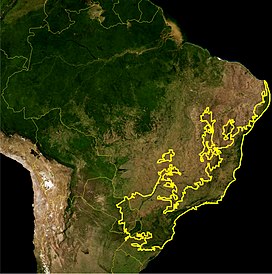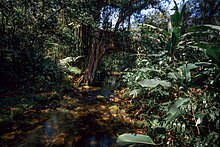
Back الغابة الأطلسية Arabic Viesca atlántica AST Alas Atlantik BAN Атлантычны лес Byelorussian Бразилска атлантическа гора Bulgarian Mata Atlàntica Catalan Atlantický les Czech Coedwig yr Iwerydd Welsh Mata Atlântica German Atlantikaj arbaroj Esperanto
| Atlantic Forest Mata Atlântica | |
|---|---|
 Area of the Atlantic Forest in Serra do Mar | |
| Map | |
 Map of the Atlantic Forest ecoregions as delineated by the WWF. The yellow line approximately encloses the forest's distribution. (Satellite image from NASA) | |
| Geography | |
| Location | Argentina, Brazil, Paraguay |
| Area | 1,315,460 km2 (507,900 sq mi) |
| UNESCO World Heritage Site | |
|---|---|
 | |
| Location | Brazil |
| Includes | Una Biological Reserve, PAU Brazil CEPLAC Experimental Station, Veracruz Station, Pau Brasil National Park, Descobrimento National Park, Monte Pascoal National Park, Linhares Forest Reserve and Sooretama Biological Reserve |
| Criteria | Natural: ix, x |
| Reference | 892 |
| Inscription | 1999 (23rd Session) |
| Area | 111,930 ha |
| UNESCO World Heritage Site | |
|---|---|
 View from a trail in the Salto Morato Reserve | |
| Official name | Atlantic Forest South-East Reserves |
| Location | Paraná and São Paulo, Brazil |
| Includes | 25 protected areas |
| Criteria | Natural: (vii)(ix)(x) |
| Reference | 893rev |
| Inscription | 1999 (23rd Session) |
| Area | 468,193 ha (1,807.70 sq mi) |
| Coordinates | 24°10′S 48°0′W / 24.167°S 48.000°W |
The Atlantic Forest (Portuguese: Mata Atlântica) is a South American forest that extends along the Atlantic coast of Brazil from Rio Grande do Norte state in the northeast to Rio Grande do Sul state in the south and inland as far as Paraguay and the Misiones Province of Argentina, where the region is known as Selva Misionera.
The Atlantic Forest has ecoregions within the following biome categories: seasonal moist and dry broad-leaf tropical forests, tropical and subtropical grasslands, savannas, and shrublands, and mangrove forests. The Atlantic Forest is characterized by a high biodiversity and endemism.[1]
It was the first environment that the Portuguese colonists encountered over 500 years ago, when it was thought to have had an area of 1,000,000–1,500,000 km2 (390,000–580,000 sq mi), and stretching an unknown distance inland, making it, back then, the second largest rainforest on the planet, only behind the Amazon rainforest.[2] Over 85% of the original area has been deforested, threatening many plant and animal species with extinction.[3][4][5]
- ^ Dafonseca, G. 1985. The Vanishing Brazilian Atlantic Forest. Biological Conservation 34:17-34.
- ^ Por, Francis Dov. 1992. Sooretama: the Atlantic rain forest of Brazil. The Hague: SPB Academic Pub.
- ^ "The Atlantic Forest". The Nature Conservancy.
- ^ "Atlantic Forests, South America". WWF.
- ^ De Lima, Renato A. F.; Dauby, Gilles; De Gasper, André L.; Fernandez, Eduardo P.; Vibrans, Alexander C.; Oliveira, Alexandre A. De; Prado, Paulo I.; Souza, Vinícius C.; F. De Siqueira, Marinez; Ter Steege, Hans (2024-01-12). "Comprehensive conservation assessments reveal high extinction risks across Atlantic Forest trees". Science. 383 (6679): 219–225. doi:10.1126/science.abq5099.
© MMXXIII Rich X Search. We shall prevail. All rights reserved. Rich X Search